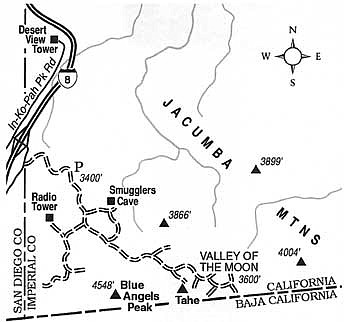 Facebook
Facebook
 X
X
 Instagram
Instagram
 TikTok
TikTok
 Youtube
Youtube
Strolling through the aptly named Valley of the Moon, you might think that a square-mile patch of Joshua Tree National Park has been magically transported there -- minus, of course, the famous Joshua trees. Ponderous outcrops of granitic rock, seamed with horizontal and vertical cracks, ring the valley.
Valley of the Moon lies just north of the Mexican border in the Jacumba Mountains, east of Jacumba. From downtown San Diego, drive east on Interstate 8 for 70 miles and exit at In-Ko-Pah Park Road (this is along the San Diego/Imperial County line, and just short of where the eastbound I-8 lanes take a precipitous plunge toward the desert floor). Turn right at the stop sign and continue southwest 0.2 mile on a frontage road to a dirt road on the left. Using a high-clearance vehicle, you should be able to drive all the way to Valley of the Moon, about 3 miles, negotiating bumps and ruts most of the way. There's a large turnout 0.8 mile up the road for those unwilling to tackle the rougher sections farther on. Those with low-slung passenger cars should hoof it all the way up the dirt road. Another option is to use a mountain bike the entire distance.
Whether by car, by foot, or by bike, your route takes you generally southeast over rocky hill and dale. Spur roads diverge left and then right. The first road branching left leads to Smuggler's Cave, once a haven of bandits and smugglers, and more recently the target of graffiti artists. The spur road on the right leads toward a prominent, stony peak labeled Blue Angels on topographic maps, and border marker #231, part of the string of 258 international boundary markers along the Mexican border between the Pacific Ocean and the Gulf of Mexico.
Eventually, by staying on the main road, you'll travel southeast to the base of a peaklet dubbed Tahe (which contains an abandoned amethyst mine) and veer east into Valley of the Moon. The valley's sandy floor is dotted with spiky clumps of Mojave yucca, spiny catclaw bushes, clumps of Mormon tea (used by early pioneers to brew a potent beverage), and buckwheat bushes. Old jeep roads meander amid the statuesque boulder heaps on the valley's south side. Photographers should be here early or late in the day, when the sun bathes the stone battlements in warm light and crisp shadows march across the valley.
The Valley of the Moon area is open to camping and lies within the jurisdiction of the Bureau of Land Management, El Centro Resource Area (phone 760-337-4400). Be aware that March is the windiest month in the high desert, and wind gusts can carry away any tent not securely staked to the ground.


Strolling through the aptly named Valley of the Moon, you might think that a square-mile patch of Joshua Tree National Park has been magically transported there -- minus, of course, the famous Joshua trees. Ponderous outcrops of granitic rock, seamed with horizontal and vertical cracks, ring the valley.
Valley of the Moon lies just north of the Mexican border in the Jacumba Mountains, east of Jacumba. From downtown San Diego, drive east on Interstate 8 for 70 miles and exit at In-Ko-Pah Park Road (this is along the San Diego/Imperial County line, and just short of where the eastbound I-8 lanes take a precipitous plunge toward the desert floor). Turn right at the stop sign and continue southwest 0.2 mile on a frontage road to a dirt road on the left. Using a high-clearance vehicle, you should be able to drive all the way to Valley of the Moon, about 3 miles, negotiating bumps and ruts most of the way. There's a large turnout 0.8 mile up the road for those unwilling to tackle the rougher sections farther on. Those with low-slung passenger cars should hoof it all the way up the dirt road. Another option is to use a mountain bike the entire distance.
Whether by car, by foot, or by bike, your route takes you generally southeast over rocky hill and dale. Spur roads diverge left and then right. The first road branching left leads to Smuggler's Cave, once a haven of bandits and smugglers, and more recently the target of graffiti artists. The spur road on the right leads toward a prominent, stony peak labeled Blue Angels on topographic maps, and border marker #231, part of the string of 258 international boundary markers along the Mexican border between the Pacific Ocean and the Gulf of Mexico.
Eventually, by staying on the main road, you'll travel southeast to the base of a peaklet dubbed Tahe (which contains an abandoned amethyst mine) and veer east into Valley of the Moon. The valley's sandy floor is dotted with spiky clumps of Mojave yucca, spiny catclaw bushes, clumps of Mormon tea (used by early pioneers to brew a potent beverage), and buckwheat bushes. Old jeep roads meander amid the statuesque boulder heaps on the valley's south side. Photographers should be here early or late in the day, when the sun bathes the stone battlements in warm light and crisp shadows march across the valley.
The Valley of the Moon area is open to camping and lies within the jurisdiction of the Bureau of Land Management, El Centro Resource Area (phone 760-337-4400). Be aware that March is the windiest month in the high desert, and wind gusts can carry away any tent not securely staked to the ground.
